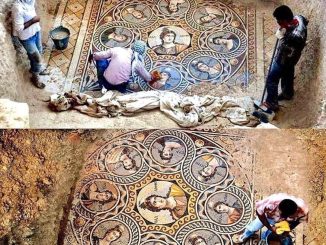Archaeologists in Italy have discovered a remarkable cache of 24 Etruscan and Roman bronze statues in the remains of an ancient religious sanctuary, hailing the find as the most important of its kind in fifty years.




The treasure trove includes tiny bronze replicas of human body parts, thrown into the thermal waters of the sanctuary by people suffering from illnesses and hoping to be healed.
The objects, found during a digging campaign between June and October, date from between the second century BC and the first century AD.
The importance of the discovery is being likened to that of the Riace Bronzes, two full-sized, naked Greek warrior figures which were found on the seabed off the coast of Calabria in southern Italy in 1972.
The bronze statues were found in the remains of an ancient Etruscan and Roman sanctuary in Tuscany Credit: Reuters
The sanctuary, near the village of San Casciano dei Bagni in Tuscany, was a place of worship from the second century BC, first for the Etruscans and then the Romans, who conquered Etruscan lands and incorporated them into their burgeoning empire.
It was built around a hot spring in a part of Tuscany which to this day boasts natural spas where Italians flock to immerse themselves in thermal waters
Some of the bronze statues are a metre tall Credit: Reuters
The statues and objects would have been deliberately tossed into the water and have been preserved over the centuries by the thick mud at the bottom of stone-walled pools.
The tiny bronze body parts include representations of feet, hands, ears, lungs, hearts, intestines and livers, offered to the gods by people who prayed for recuperation and healing. “It’s a unique find, the most important discovery of bronzes for 50 years,” Emanuele Mariotti, the director of the archaeological site, told The Telegraph.
“They were offered to the gods as a gift. Bronze statues like this would have been very expensive to make so we are talking about the VIPs of the ancient world – powerful Etruscan families and then rich Romans, perhaps even emperors. The sanctuary was a sacred place – it was not a public thermal bath.”
The bronze statues, some of them a metre or three feet tall, represent gods and goddesses such as Apollo, Isis, Fortuna and Igea, the goddess of health.
Archaeologists have also recovered around 5,000 gold, silver and bronze coins, which Roman devotees tossed into the water.
Prof Jacopo Tabolli, the lead archaeologist at the dig, said the discovery would “rewrite history”.
The finds mean that the sanctuary is “a research laboratory on the cultural diversity of antiquity,” he said.
An aerial view of the site in Tuscany where the statues and other objects were discovered Credit: Reuters
Many of the bronze objects bear inscriptions in Latin and Etruscan and indicate that Etruscan survived for much longer as a living language than previously thought.
Massimo Osanna, the director general of museums and archeological sites, said: “It’s the most important discovery since the Riace Bronzes and is certainly one of the most significant discovery of bronzes ever made in the history of the ancient Mediterranean.”
There are plans to turn the dig site into an archaeological park and to build a museum to display the bronzes.








